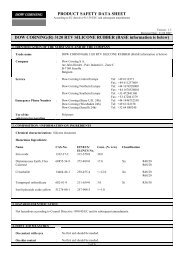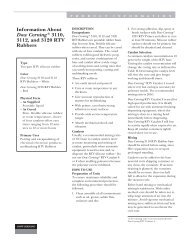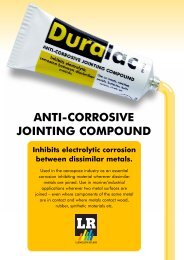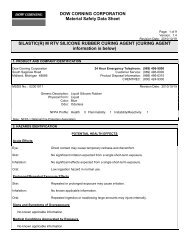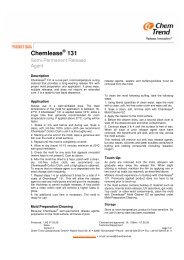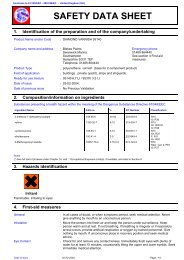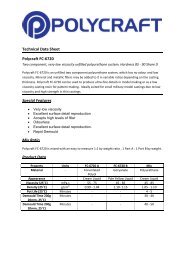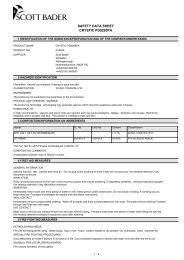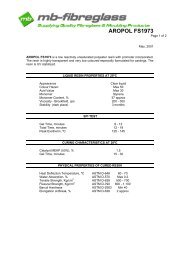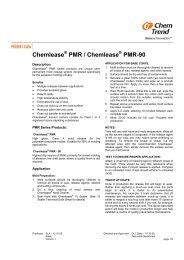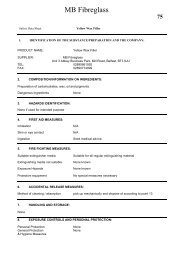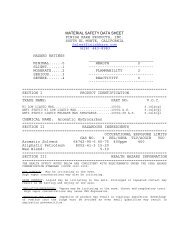High Strength, Flexible, RTV Silicone Rubbers
High Strength, Flexible, RTV Silicone Rubbers
High Strength, Flexible, RTV Silicone Rubbers
You also want an ePaper? Increase the reach of your titles
YUMPU automatically turns print PDFs into web optimized ePapers that Google loves.
TECHNICAL BULLETINPlatSil ®71 Series<strong>High</strong> <strong>Strength</strong>, <strong>Flexible</strong>, <strong>RTV</strong> <strong>Silicone</strong> <strong>Rubbers</strong>DESCRIPTION: PlatSil ® 71 Series <strong>RTV</strong> <strong>Silicone</strong> <strong>Rubbers</strong> aretwo-component, addition-cure, platinum-catalyzed, flexible,mold compounds. The 71 Series products exhibit a tough, knottytear, making them especially valuable to the mold making industry.They are excellent mold materials for casting polyester,epoxy and polyurethane resins, as well as for waxes and manyother materials. PlatSil 71 Series products offer advantages overtin-catalyzed systems in certain applications because on curingthey don’t shrink and don’t produce alcohol (like tin-catalyzedsilicones), which can inhibit urethane castings.MODEL PREPARATION: Seal porous models (i.e., wood orplaster) with wax, petroleum jelly, lacquer or paint to preventpenetration of the rubber into the pores of the material. The modeland other surfaces that contact the liquid rubber should be coatedlightly with Pol-Ease ® 2350 Release Agent or sprayed with Pol-Ease 2500 Release Agent. Pol-Ease 2350 is both a sealer andrelease agent and must be allowed to dry before applying liquidrubber. Pol-Ease 2500 is an aerosol spray and does not need todry before applying liquid rubber. Do not use silicone-basedrelease agents (i.e., Pol-Ease 2300) on surfaces that contact liquidPlatSil rubbers since inhibition and/or adhesion may occur.In every case where there is any question about the compatibilitybetween the rubber and the prepared model surface, perform a testcure on an identical surface to determine that complete curing andgood release are obtained.PlatSil 71 Series rubbers may bond to cured silicone rubbersunless a parting agent is used.Porous models must be vented from beneath to prevent trappedair from causing bubbles in the rubber.MIXING & CURING: Carefully weigh Part B then Part A inproper ratio into a clean mixing container. Accurate weighing isessential to obtain the optimum physical properties from thecured rubber. Mix thoroughly, scraping sides and bottom of thecontainer. To assure a bubble-free mold, deaerate the liquid rubberunder vacuum at 28-29 inches mercury, until the mass of rub-FEATURES & BENEFITS:• Easy mix ratios; some 1:1 mixes available• Room temperature cure or accelerate with heat• Easy release properties -- save on release agents• <strong>High</strong> tear strength -- fewer prematurely torn molds• Good chemical resistance for longer mold life• Low/zero shrinkage for dimensional reproduction• Range of hardnesses from A10 to A40ber rises and then collapses. Deaerate for additional 2 minutes.When vacuuming, use a mixing container 3 to 4 times larger thanthe volume of rubber. Do not attempt to vacuum fast setting 71-10. (Note: PlatSil 71-10 Part B and 71-20 Parts A and B requirestirring before use.)If reinforcement of the rubber is needed (i.e., thin blanket molds),place stretchy, mesh nylon or dacron cloth into the uncured rubber.Be sure that the fabric is not too close to the mold surface orthe weave of the cloth may show through to the face of the mold.PlatSil 71 Series rubbers cure faster at higher temperatures. To reachfull hardness in the specified demold time, temperature should beabove 77°F. At lower temperatures, more time may be needed toreach full hardness. Curing below 65°F is not recommended.Note on SiliGlass: Demold Siliglass within 0.5-1 hr after mixingto prevent crumbling upon demolding. As curing progresses,Siliglass becomes harder and the likelihood of breaking increases.CURE INHIBITION: CAUTION! Contamination from amines,sulfur, tin compounds, cured polyester resins, or some <strong>RTV</strong> siliconerubbers may inhibit surface cure. If in doubt, test compatibilityby pouring a small quantity of catalyzed material on the surfaceto be reproduced, allow to cure and observe for proper cureand release.PHYSICAL PROPERTIES71-10 71-11 71-20 71-30 71-35 71-40 SiliGlassMix ratio, by weight 1A:10B 1A:1B 1A:1B 1A:10B 1A:10B 1A:5B 1A:1BHardness, Shore A 10 10 20 30 35 40 40Pour Time (min) 5 20 25 60 60 60 5Demold Time (hr) @ 77°F 0.5 4 4 24 24 24 0.5-1Color Pink Blue Green Lt. Purple Lt.Green Blue Translucent ClearMixed Viscosity (cP) 3,500 6,000 12,000 25,000 25,000 25,000 200Specific Volume (in 3 /lb) 26 24.7 24.7 24.7 24.7 25 28Specific Gravity 1.06 1.12 1.12 1.12 1.12 1.10 0.97Shrinkage Upon Cure Nil Nil Nil Nil Nil Nil Nil55 Hilton Street, Easton, PA 18042 • (800) 858-5990 or (610) 559-8620 • fax (610) 559-8626 • www.polytek.com • sales@polytek.com
PACKAGINGProduct Unit Weight Container Volume Net Weight (lb)(lb) A B A BPlatSil ® 71-11, 71-20, SiliGlass 2.0 1 pt 1 pt 1.0 1.0Mix Ratio 1A:1B 16.0 1 gal 1 gal 8.0 8.080 5 gal 5 gal 40.0 40.0PlatSil ® 71-10, 71-30, 71-35 1.0 2 oz 1 pt 0.1 0.9Mix Ratio 1A:10B 9.0 1 pt 1 gal 0.9 8.144.0 ½ gal 5 gal 4.0 40.0495 6 gal 55 gal 45.0 450PlatSil ® 71-40 9.8 1 qt 1 gal 1.7 8.1Mix Ratio 1A:5B 48.0 1 gal 5 gal 8.0 40528 2 x 6 gal 55 gal 88 440USING THE MOLD: No release agent is necessary for castingmost materials in PlatSil 71 Series molds, but for longer mold lifewith epoxy, polyurethane or polyester resins, a barrier coat orrelease agent (i.e., Pol-Ease 2300) is recommended. Properlycured PlatSil 71 Series molds last for years without deterioration.ACCELERATING CURE SPEED: Accelerate the cure withheat or the addition of PlatSil 71/73X. Mix 71/73X with Part Bprior to adding Part A. Weigh and add Part A to the acceleratedPart B mixture and mix thoroughly. Pour over a properly preparedmodel as soon after mixing as possible. The addition of 1 part71/73X per 100 parts of Part B decreases the gel time to ~1/3 thenormal gel time. The addition of 2 parts decreases the normal geltime to ~1/4. The addition of 3 parts decreases the normal gel timeto ~1/6. Experimentation on a small scale is recommended beforemaking a larger mix. Remember, heat accelerates the cure; lowtemperatures slow the cure.RETARDING CURE SPEED: PlatSil 71R added to PlatSil PartA prior to mixing with Part B slows the cure yielding longerworking time and longer demold time. Adding ~1% of 71R to thetotal mixed weight of PlatSil A+B roughly doubles the workingtime. Adding ~2% of 71R triples working time. Do not use morethan 4% as the system may not cure at all.THICKENING FOR BRUSH ON: For brushing on a skin mold,thicken PlatSil 71 Series rubbers with PlatThix liquid thickener orwith Fumed Silica When brushing PlatSil 71-11 or 71-20, applysubsequent coats to the previous layer within one hour to obtainbest adhesion.THINNING AND SOFTENING WITH SILICONE FLUID:The very low viscosity 50 cSt PolySil ® <strong>Silicone</strong> Fluid can beadded sparingly to the mixed rubber to thin the mix with someloss of strength, hardness and cure speed. More than 10% fluidaddition may exude from the cured rubber. A 5% addition toPlatSil 71-30 will reduce hardness to approximately Shore A22.BARRIER COAT: A barrier coat is a fast drying, lacquer-likeprimer that is sprayed into a silicone mold and allowed to dryprior to pouring liquid plastic. Upon removing the cured plasticcasting from the mold, the barrier coat comes out on the plasticcasting resulting in a primed part. Also, using a barrier coat canextend mold life.SAFETY: Before use, read product labels and Material SafetyData Sheets. Follow safety precautions and directions. Avoid contactwith mucous membranes and eyes. Best method of cleanup isby wiping with paper towels, then washing with soap and water.If solvents must be used, denatured ethanol is good, but handlewith extreme caution owing to its flammability and health hazards.STORAGE LIFE: At least six months in unopened containers storedat room temperature (60-90°F). Tightly reseal opened containers.DISCLAIMER: The information in this bulletin and otherwiseprovided by Polytek ® is considered accurate. However, no warrantyis expressed or implied regarding the accuracy of the data,the results to be obtained by the use thereof, or that any such usewill not infringe any patent. Before using, the user shall determinethe suitability of the product for the intended use and userassumes all risk and liability whatsoever in connection therewith.ACCESSORIESPol-Ease ® 2300 Release Agent12-oz aerosol can, case of 12 cansPol-Ease ® 2350 Release Agent1 qt (1.5 lb), 5 gal (26 lb)Pol-Ease ® 2500 Release Agent12-oz aerosol can, case of 12 cansPlatThixFor Thickening PlatSil <strong>Rubbers</strong>4 oz, 1 pt (1 lb)<strong>Silicone</strong> Fluid 50 cStFor Thinning PlatSil <strong>Rubbers</strong>1 qt (2 lb), 1 gal (8 lb), 5 gal (40 lb)PlatSil ® 71/73X Accelerator4 oz, 1 pt (1 lb), 1 gal (8 lb)PlatSil ® 71R Retarder4 oz, 1 pt (1 lb), 1 gal (8 lb), 5 gal (40 lb)Barrier PF1 qt (1.5 lb), 5 gal (35 lb)Fumed Silica5 gal, 1 bag (10 lb)111709/PlatSil71.qxp55 Hilton Street, Easton, PA 18042 • (800) 858-5990 or (610) 559-8620 • fax (610) 559-8626 • www.polytek.com • sales@polytek.com


